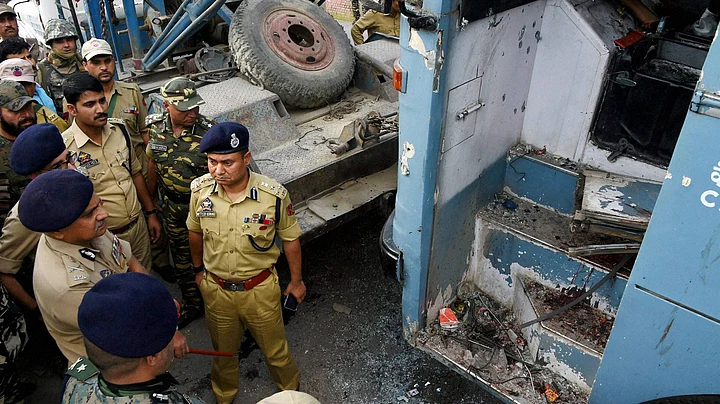Those who understand do not have the power to decide, and those who decide don’t understand.An unnamed mid-ranking CRPF officer (Force magazine, May 2010)
When the
nation watches video feed on news TV channels of a stationary grey bus on a
flat bit of road in Pampore (J&K), leading to a bend, and a little bridge and hears the sound of prolonged machine-gun fire, it is natural for its
consternation to rise. Why was the CRPF being shot up like ‘sitting ducks’ yet
again?
The CRPF bus, without armour, or bullet-proofing, but with 28 jawans on board, was attacked by just two LeT terrorists with AK-47s perpetrating the massacre. Ironically, nobody on the bus had weapons, even though the CRPF personnel were returning to base after a bout of shooting practice.
The terrorists,
meanwhile, had enough time to change magazines three times, and shoot at
everyone, leaving eight dead and the rest injured in varying degrees.
Gaps in Security
Security forces in escort vehicles finally arrived and killed the two terrorists standing alongside the bus, even as another two drove off in the car they had arrived in. These latter are still at large, despite the ordering of a high-alert manhunt.
Questions are now being raised on the gaps in security of a national highway in a sensitive area where the incident took place.
Meanwhile, another video showed 40 heavily armed terrorists crossing over in a thickly wooded border area of Kashmir in bright sunlight, passing with a nod and a smile at the camera. This footage has been recovered by the security forces from the belongings of another Pakistani terrorist killed elsewhere.
SOP Not Followed
The LeT terrorists in the Pampore attack, it is speculated, were part of the 40 who crossed over earlier. Despite knowing this, the CRPF bus went absolutely unprotected.
Defence Minister Manohar Parikkar, remarking on Sunday’s massacre from Bhubaneswar, said the Pampore attack was “an act of frustration” since 25 terrorists have been killed by Indian security forces in the last month alone. He blithely blamed this latest debacle on the jawans not following ‘standard operating procedure’, but without once wondering at the state of discipline in the CRPF.
No Change on the Ground
Home Minister Rajnath Singh, under whose charge the CRPF comes, also does not miss an opportunity to make thunderous declarations every time its troops are murdered. But on the ground there are no visible changes to prevent future attrition and enhance preparedness.
It is no wonder, therefore, that a grinning Pakistani ambassador to India, Abdul Basit, blithely carried on with his iftar party as news of the Pampore massacre came in.
Our media too made more of Basit’s boorishness and undiplomatic insolence than the shocking ineptitude of the CRPF leadership. In the topsy-turvy world we live in, they even reported protests at J&K Chief Minister Mehbooba Mufti’s condemnation of the attack as “unIslamic”, especially during Ramzan.
CRPF’s Unprofessionalism
Indeed, the larger question of the CRPF’s unprofessionalism is not being addressed by anyone in the political establishment as yet.
Nothing appears, therefore, to have changed, at a policy and implementation level since 80 CRPF personnel were ambushed in Dantewada, 76 of them killed outright, in May 2010.
After a period of ritualistic mea culpa, replete with solemn obsequies, every time there is a fresh massacre the establishment goes back to its horrifying inertia.
The Centre and the state governments and the CRPF/BSF leadership have certainly not come any closer to preventing the regular slaughter of our para-military forces.
Continuing to be Soft Targets
- The attack on CRPF troops in Pampore in J&K is another instance of security
blunder as the 28 jawans were on board a bus which was not bullet-proof.
- The terrorists had enough time to change magazines
three times and fired 200 shots at the unprotected bus.
- CRPF is a spent force dealing with high rate of attrition and lack of
funds.
- The political establishment is to be blamed for not initiating urgent changes to prevent attrition and increase military preparedness.
- The paramilitary force usually comprises IPS officers, who are unable to assess security
needs in Maoist-infested jungles and insurgent-prone tribal areas.
- MHA bureaucrats and the political leadership must act to fix the deep structural flaws.
High Attrition Rate
In fact, all along the line the attrition rate in both these organisations has been significantly higher than the army. Their funding, equipment, training, morale, discipline and living standards leave much to be desired. The CRPF has witnessed a rush for exits, via its VRS programme, at three times the rate of the army.
The CRPF’s operational leadership too is not provided by its own career officers but by senior IPS officers policemen deputed for a tour of duty.
Structural Changes
Whether such essentially administrative cadre policemen understand the specialised needs of countering highly armed and trained guerrilla warfare is the moot question. Does the IPS have the training and experience to comprehend and anticipate what is at stake in high-risk areas such as the Maoist-infested jungles of central India, the insurgent areas in the mountainous North East or the perennially Islamic terrorist-ridden Kashmir valley?
Do home ministry bureaucrats and the political leadership that sits atop this unwieldy and ad hoc organisation realise the need for deep structural changes?
This jugaad style and perpetual unpreparedness is a problem that has plagued the CRPF throughout the earlier UPA administration too, but without finding any tangible solution. Will the Modi administration, that professes a deep concern about the well-being of our armed forces, do something to urgently improve matters now?
(Gautam Mukherjee is a plugged-in commentator and instant analyser. He can be reached at @gautammuk)
Also read:
Pampore: Won’t Count Bullets While Retaliating, Warns Rajnath
(At The Quint, we question everything. Play an active role in shaping our journalism by becoming a member today.)
